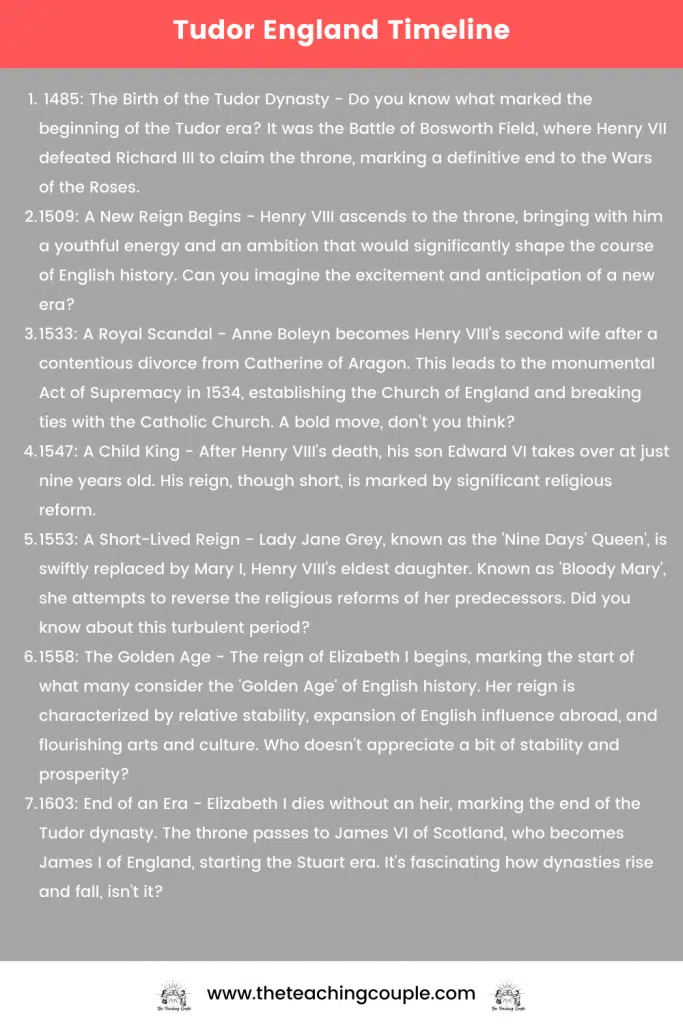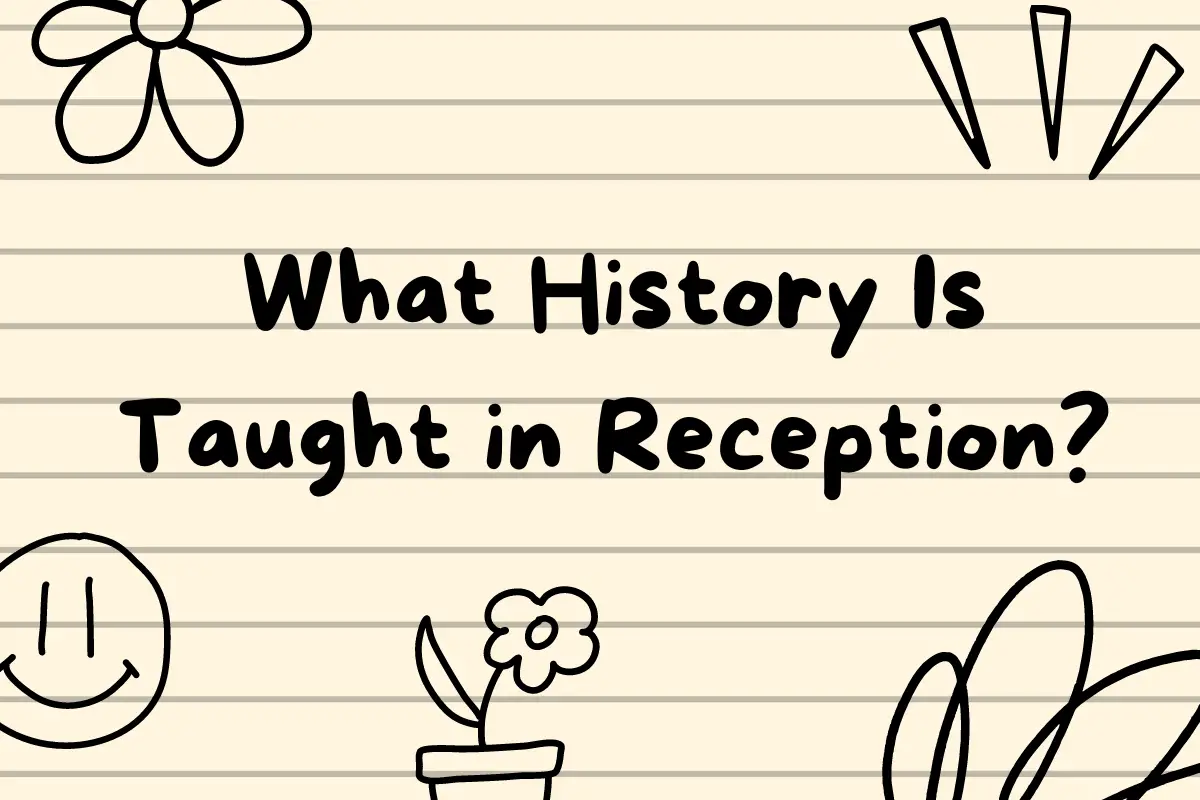Do your students need help keeping up with all the information in their Tutor’s history lessons? Teaching about this period can be overwhelming for teachers and students alike. With so much content and detail, you must plan your lesson effectively so your students understand key events and facts.
This blog post will provide a comprehensive overview of planning a successful Tudor history lesson – from building background knowledge to assessment advice.
Whether you teach primary or secondary school, the tips provided here should help ensure your lesson preparation is as organized and efficient as possible. Read on for an indispensable guide to effective teaching in the era of The Tudors!

Introducing The Tudor Dynasty
The Tudor Dynasty is one of the fascinating periods of British history. This era saw the rise of a formidable family whose reign lasted over a century, from 1485 to 1603.
Led by a series of powerful monarchs like Henry VII, Henry VIII, Edward VI, Mary I, and Elizabeth I, the Tudors left an indelible mark on the country’s cultural, political, and social landscape. Grand pageantry, religious upheavals, wars, and a blossoming of artistic and literary expression marked their reign.
The Tudor period also saw the birth of the English navy, the establishment of the Church of England, and the beginning of the English Reformation.
From the infamous beheading of Anne Boleyn to the triumphs of Elizabeth I, the Tudors’ legacy continues to captivate historians, scholars, and the public alike.
Overview Of The Most Significant Events In Tudor England
Tudor England was a tumultuous change, with significant events shaping history for centuries. From the rise of the Tudor dynasty under Henry VII to the iconic reign of Elizabeth I, the period was marked by political and religious upheaval.
The most significant events in Tudor England included the break from Rome and the establishment of the Church of England, the Spanish Armada, the reign of King Henry VIII, and the turbulent reigns of Mary Tudor and Elizabeth I, among others.
These events were critical in shaping England’s social, political, and religious landscape, leaving an indelible mark on English history.
Discuss The Legacy Of The Tudors
The Tudors, one of England’s most iconic royal dynasties, profoundly impacted the country’s culture and politics. Their reign spanned a tumultuous period in history, marked by religious upheavals, social changes and the expansion of the British empire.
The Tudors were known for their elaborate court culture, opulent dress, lavish entertainment and sophisticated art.
Queen Elizabeth I, in particular, was a patron of the arts and literature, and her reign is considered a golden age of English literature. On the political front, the Tudors consolidated their power through efficient administration and propaganda.
They established a centralized government and laid the foundation for modern parliamentary democracy. The Tudors may be long gone, but their legacy is still felt today, shaping the identity of England and its people.
Breakdown Of A Typical Day In A Tudor Household
In the Tudor era, the daily routine of a household looked quite different from what we are used to today. A typical day in a Tudor household started early in the morning, with the day’s first task being to light the fire.
Once the fire was going, the lady of the house would supervise the preparations for breakfast, which would typically include bread, a meat dish, and ale.
After breakfast, the gentlemen of the house would tend to their daily business while the lady would attend to her duties. These would include overseeing the cooking of meals for the rest of the day, managing any staff or servants, and listening to the children.
The afternoon was typically spent on leisure activities such as hunting and socializing, followed by a hearty dinner in the early evening.
As the day ended, the family would retire to bed, with the servants staying up later than their masters to ensure everything was for the following day.
How Tudor Customs Influenced Today’s Society
The Tudor era was fascinating, full of unique customs and traditions influencing our society today. From fashion to food, Tudor culture has impacted our lives today.
One of the most prominent Tudor customs was the idea of courtly love, where chivalrous knights would devote themselves to a lady and engage in romantic gestures.
This concept has influenced our modern-day ideas of romance and courtship. Additionally, with its elaborate ruffs and doublets, Tudor fashion has inspired modern-day fashion designers.
Overall, there are countless ways in which Tudor customs have shaped our society, making it essential to analyze their impact and continue to learn from them.
Tudor Fashion and Clothing
Tudor fashion and clothing were unique and complex, and they helped to define the social and economic status of individuals within Tudor society. The dress the Tudor nobility wore was intricate, colourful and made from various fabrics, including wool, silk, velvet and linen.
Fashion during the Tudor era was used to set individuals apart based on their social class and status. Sumptuary laws regulated the clothing and accessories that could be worn, depending on an individual’s position in Tudor society.
For example, only the king, queen, and specific members of the aristocracy were allowed to wear certain colours, such as ermine, purple, and gold. People experiencing poverty were limited to wearing simple and often drab clothing.
The Tudor period witnessed many changes in fashion, with new trends and ideas emerging. For example, Tudor men’s clothing often included a doublet and hose – close-fitting garments that were padded to create a fashionable silhouette.
On the other hand, women’s attire had dresses with full skirts, which helped to accentuate the waist and create an extremely feminine look.
Jewellery and other accessories were also significant elements of Tudor fashion, reflecting the wearer’s social status. For example, wealthy ladies wear fine jewellery, including necklaces, bracelets, and earrings, often made using precious stones such as diamonds and rubies.
Sumptuary Laws of the Tudor Era
Sumptuary laws were regulations imposed by the Tudor government to control and restrict clothing and accessories worn by individuals in England based on their social rank and status.
These laws were designed to ensure that members of the lower class did not try to emulate or copy the dress of the higher course, which could lead to confusion about a person’s actual social standing.
Sumptuary laws outlined the types of fabrics, colours and trims permitted for each class, depending on their social style and rank, and restricted the use of certain materials by everyone except for the most privileged.
For example, individuals from the lower class were forbidden from wearing the most luxurious fabrics like silk and velvet, and only those from the highest rank could wear ermine and gold.
The Tudor government used sumptuary laws to control and regulate the fashion industry, and individuals who broke these laws faced severe penalties. Penalties ranged from fines to imprisonment and, in some cases, even death in extreme cases.
The sentences depended on the offence’s severity; for example, a wealthy individual wearing more luxurious fabric than allowed was fined. A commoner who wore prohibited clothing may have been imprisoned or punished with labour.
In effect, sumptuary laws of the Tudor era were a playful way for the state to control the upper and lower class, their lifestyle, and status, preserving social hierarchies.
However, despite these restrictions, Tudor clothing became renowned in British history for its unique style and taste for the luxury of expensive fabrics and high-end accessories.
Teaching Opportunities Related to the Tudors
- History lessons: Teaching Tudor history can provide students with an understanding of the workings of the monarchy and the political, economic and social structures in England during the 16th century.
- English Literature lessons: The Tudor era was the time of Shakespeare so students can learn more about the works of the famous playwright and other Tudor writers. These works can provide insight into the relationship between literature and society.
- Art and culture lessons: Tudor England significantly impacted the development of English art and culture, an area in which students can delve and further understand the evolution of the arts in England.
- Religious education lessons: Tudor England includes the religious upheaval during Henry VIII’s reign and the splitting of Rome. This gives students a deeper understanding of the impact of religion on society in different historical contexts.
- Gender studies lessons: Elizabeth I’s reign broke gender stereotypes, making learning about Tudor England a perfect opportunity to study women’s role in power and society.
- Drama and performance lessons: Students can recreate stage performances from the Tudor era. These performances require students to learn about acting techniques, stage design and other elements that bring plays to life.
- Fashion and clothing lessons: Tudor fashion and clothing were colourful, distinctive and significant in defining the hierarchy and status quo of Tudor society. This makes Tudor England an excellent opportunity for a more in-depth study of the topic.
These teaching opportunities can lead to the creation of various lesson plans, which will aid the students in learning and developing their skills in different subjects, including history, literature, art, religion, drama, and more.
Lesson Plans
Lesson Plan 1: Tudor-Era Fashion Show
Overview
This lesson plan involves students researching and creating designs inspired by Tudor-era clothing and accessories. Students will use their research to create historically accurate and unique designs to incorporate into a fashion show.
Learning Objectives
- Develop research skills
- Develop creative thinking and design skills.
- Learn about the social hierarchy and sumptuary laws.
Procedure
- Introduce the concepts of Tudor-era fashion and sumptuary laws to the students.
- Assign each student to research a specific aspect of Tudor-era clothing and accessories.
- Ask students to create historically accurate designs using Tudor-era styles and fabrics.
- Schedule a day for a fashion show where each student will present their design.
- Students will explain their designs and how they fit into Tudor-era society.
- Reflect on the role of fashion in maintaining social stratification in Tudor, England.
Lesson Plan 2: Poetry and Music of the Tudors
Overview
This Literacy/Language Arts lesson plan involves students studying the poetry and music of the Tudor era. Exploring the works of famous Tudor poets and musicians, such as William Shakespeare and Thomas Tallis, will also be studied to gain a deeper insight into the culture and history of the Tudor era.
Learning Objectives
- Understanding the historical importance of Tudor poetry and music
- Develop critical thinking and analysis skills.
- Learn the relationship between arts and society.
Procedure
- Begin by introducing famous Tudor poets and musicians and their work.
- Assign each student a famous Tudor poet or musician to research and study their work.
- After conducting research, students will present their findings to the class.
- The students can host a poetry slam, where they read and discuss the works of Tudor poets.
- Students can listen to and critique Tudor music, including those by Thomas Tallis or collect and present their compositions.
Lesson Plan 3: Role-Playing a King’s Court
Overview
This lesson plan involves students role-playing the life of a Tudor king’s court. Students will understand the power dynamics of Tudor society and learn about the roles played by different people in the community.
Learning Objectives
- Develop critical thinking and analysis skills.
- Learn about the social hierarchy and power dynamics in Tudor society.
- Learn how to evaluate character traits.
Procedure
- Assign students a role, such as the king, queen, or court member of a specific Tudor monarch.
- Students will research and learn about the customs, speech style, fashion and behaviour of their role.
- The students will then act out a day in the life of the Tudor monarch and their court, paying attention to precise details.
- Teachers need to make time for students’ discussions on the different character traits they had to adopt and decipher the power dynamics in the classroom.
- Finally, students will summarise their role and how they gave it to the class, encouraging them to develop reflective, analytical skills.








yacht mieten ostsee
At the beginning, I was still puzzled. Since I read your article, I have been very impressed. It has provided a lot of innovative ideas for my thesis related to gate.io. Thank u. But I still have some doubts, can you help me? Thanks.